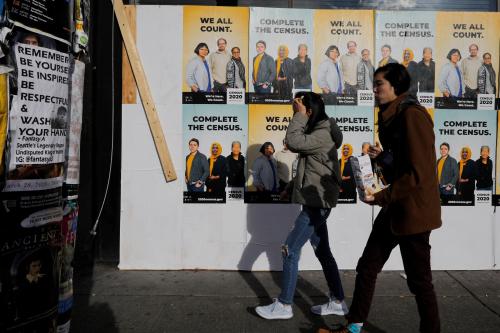Population dispersal from big metro areas coincided with the late 2010s economic rebound
In the past few weeks, the COVID-19 pandemic has led to some big-city residents relocating to summer homes and other less dense places in the hopes of avoiding the coronavirus. While this is a temporary phenomenon in response to a crisis, recently released Census Bureau statistics reveal such relocations dovetail with a longer-term, national dispersal away from large metropolitan area populations. This is a reversal from the early 2010s, which witnessed an unusually large growth surge for many of the nation’s biggest metropolises and cities.
As big-city growth continued through mid-decade, many observers, including myself, heralded the 2010s as “the decade of the city.” However, the new Census Bureau estimates documenting annual population change through July 2019 make plain that any decade-wide growth for large metro areas and urban cores is heavily front-loaded from the beginning of the decade, as growth has diminished in recent years.
Major metropolitan areas with populations exceeding 1 million sustained the biggest growth slowdowns and, in several cases, population losses over the last four years, as have the urban cores within them. All of this occurred at a time when national population growth has reached historic lows.
As the urban population disperses, smaller metropolitan areas, suburban counties, and populations residing outside of metropolitan areas are seeing more modest growth declines and even additional population gains.
This recent demographic dispersal can be attributed to an upturn in the economy and, to a lesser degree, the housing market in the last half of the 2010s. These factors gave young adult millennials and others the wherewithal to find jobs and homes in suburbs and more parts of the country, which were not available to them in the immediate aftermath of the 2007 to 2009 Great Recession.
Of course, the economic consequences of the COVID-19 crisis may change all of this, raising questions about the nature of population shifts in the years to come.
Diminished growth for America’s biggest metropolises
Figure 1 displays the broad patterns of annual population growth over the 2010 to 2019 period for the aggregated populations of the nation’s 53 major metropolitan areas, 331 other metro areas with smaller populations, and the 13.8% of the U.S. population that resides outside of metropolitan areas.

Quite clearly, major metropolitan areas showed the biggest growth slowdowns—almost halving their aggregate growth rates—between the early and later years of the decade. In contrast to much of the 2000 to 2010 decade, these large areas enjoyed a growth surge through the first five years of the 2010s, dwarfing the growth rates for smaller areas. But those rates began to dip as the decade wore on.
These growth declines took on different trajectories for individual metropolitan areas (download Table A). The nation’s three biggest metropolises—New York, Los Angeles, and Chicago—began the decade with positive growth rates that turned negative over the past several years. In fact, seven of the 11 largest metropolitan areas—including Washington D.C., Miami, Philadelphia, and Boston—registered their highest growth rates of the decade in either 2010 to 2011 or 2011 to 2012. This is the case for 11 other major metropolitan areas. Several of these became “holding areas” during a period when overall migration to moderate-sized places, especially in Sun Belt, was abated in the immediate post-recession period.

Other major metro areas, including faster-growing areas in the South and West such as Houston, Atlanta, and Denver, did not reach their growth peaks until the middle of the decade. But most of those also witnessed growth declines in the last several years. Fully 48 major metro areas showed peak growth during the first six years of the decade and only one—Tucson, Ariz.—realized its highest decade growth in 2018 to 2019.
These trends are also apparent when examining absolute population losses among major metro areas. In 2010 to 2011, only three of the nation’s 53 major metro areas—Cleveland, Providence, R.I., and Buffalo, N.Y.—registered population declines. However, that number rose over the course of the decade, with 12 areas sustaining population losses in 2018 to 2019. These include several heartland metro areas such as Chicago, Cleveland, Pittsburgh, Detroit, and St. Louis, as well coastal areas including New York, Los Angeles, and San Jose, Calif. (Download Table B)
Despite the pervasive slowdown in growth, major metro areas did exhibit a range of growth levels. Even in 2018 to 2019, growth rates ranged from a high of 2.8% for Austin, Texas to a low of -0.3% for New York.
Metro areas with smaller populations, as a group, also registered reduced growth in the last few years, though far less marked. Unlike earlier in the decade, they grew faster than the largest areas in 2018 to 2019. At the same time, the nation’s nonmetropolitan territory began to show glimmers of growth after losing population for most of the decade.
Domestic migration shifts to smaller metro areas and nonmetropolitan counties
The slower population growth that the nation as a whole is now experiencing is a result of reduced immigration from abroad, lower fertility over the past few years, and rising numbers of deaths associated with an aging population. These dynamics have impacted most areas regardless of size.
This leaves domestic migration (movement within the nation) as a key driver of population dispersion across metropolitan areas. As Figure 3 shows, major metropolitan areas as a group were the beneficiaries of domestic migration from 2010 to 2015 through movement from nonmetropolitan territory and modest exchanges with smaller metropolitan areas. Yet that movement reversed afterward, when these metro areas began losing migrants, mostly to smaller metro areas (though migration out of nonmetropolitan territory was greatly reduced as well).

Not all 53 major metro areas followed this exact pattern. Many experienced in-migration at different levels over the course of the decade, and others experienced out-migration at different levels. But the broad patterns show large numbers of migrants relocating into smaller-sized metropolitan areas. In fact, more than half of the migrant-losing metro areas saw their greatest migration losses in the last four years of the decade, with the biggest losses in New York, Los Angeles, Chicago, and Miami.
Dispersal from urban cores to suburbs and exurbs
Another dimension of the late-decade population dispersal is reduced growth or decline in the urban core counties of the nation’s large metropolitan areas. Using a county typology developed by the Brookings Metropolitan Policy Program, Figure 4 shows how growth in highly dense urban core counties thinned across the last four years, from 0.8% in 2015 to 2016 to just 0.1% in 2018 to 2019.

Among the 68 urban core counties with populations exceeding 500,000 people, 30 registered a population loss in 2018 to 2019, and 60 grew less or lost more population than in 2014 to 2015. These urban core counties are located in all parts of the country, within both growing and declining metro areas. Among them are the District of Columbia, San Francisco County, Calif., and Kings County (Brooklyn), N.Y.—places known to attract young professionals in the early years of the 2010s.

Likewise, there are complimentary gains in less dense emerging and exurban counties, which picked up in the last few years. Examples include Johnson County, Texas in suburban Dallas, where annual growth rose from 0.5% to 2.7% between 2010 to 2011 and 2018 to 2019; and Dawson County, Ga. in suburban Atlanta, where growth rose from 0.1% to 3.9% over the same period.
2020 and beyond
The 2010s decade, on the whole, will be seen as a positive one for the nation’s biggest metropolitan areas. The 2020 census will show that for the 2010 to 2020 period, large metro areas will have registered greater population gains than smaller-sized areas or nonmetropolitan territory, with the latter experiencing widespread population losses. A decade-long view also reveals substantial economic success for major metropolitan areas: According to the Brookings Metropolitan Policy Program’s Metro Monitor 2020, major metropolitan areas outperformed all others on measures of economic growth, prosperity, and inclusion for the 2008 to 2018 period.
Yet in terms of population gains, the 2010s present two different stories for major metro areas: high growth in the first half of the decade and declining growth (and in some cases, losses) in the second half.
The late-decade slowdown can be linked to a broader national economic revival, as jobs and housing began to disperse outward after contracting in the immediate aftermath of the Great Recession and housing bust. In recent years, young adult movers—who comprise an outsized share of all movers—were more willing and able to locate to smaller areas in all parts of the country and increasingly to suburbs. As a consequence, the large metro area growth surge subsided sharply, as did early-decade gains of many urban core counties.
Now, in the midst of an unprecedented pandemic and economic standstill, it is difficult to assess how or if the recent demographic dispersion will continue. A long-term recession could very well put the brakes on this dispersion and, as was the case after the Great Recession, lead to renewed metropolitan gains. On the other hand, large metropolitan areas and cities—especially those at the center of the pandemic—could become less immediately attractive to movers than they were in the early 2010s.
These are significant trends to watch going forward. And despite recent demographic reversals, major metropolitan areas—home to 56% of U.S. residents—will continue to be important anchors for the nation’s population and economy in the decade ahead.






